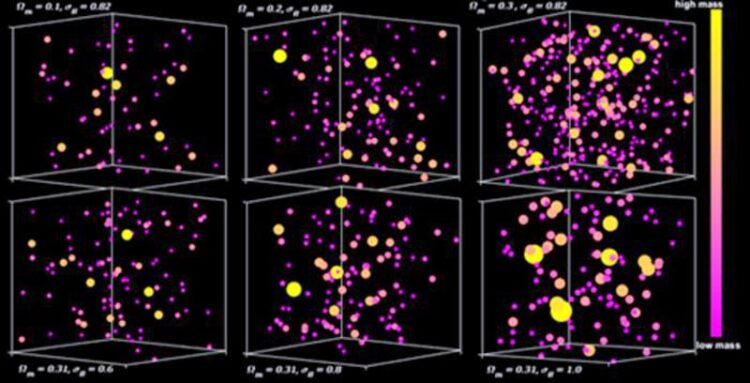Matter comprises of 31% of the total amount of matter and energy in the universe

Like Goldilocks, the team compared the number of galaxy clusters measured with predictions from numerical simulations to determine which answer was “just right.”
Credit: Mohamed Abdullah (The National Research Institute of Astronomy and Geophysics, Egypt/Chiba University, Japan)
A research team relies on measuring the number of galaxy members to determine the mass of galaxy clusters.
“Cosmologists believe that only about 20% of the total matter is made of regular or ‘baryonic’ matter, which includes stars, galaxies, atoms, and life,” explains first author Dr. Mohamed Abdullah, a researcher at the National Research Institute of Astronomy and Geophysics-Egypt, Chiba University, Japan. “About 80% is made of dark matter, whose mysterious nature is not yet known but may consist of some as-yet-undiscovered subatomic particles.” (Fig. 1)
“The team used a well-proven technique to determine the total amount of matter in the universe, which is to compare the observed number and mass of galaxy clusters per unit volume with predictions from numerical simulations,” says co-author Gillian Wilson, Abdullah’s former graduate advisor and Professor of Physics and Vice Chancellor for research, innovation, and economic development at UC Merced. “The number of clusters observed at the present time, the so-called ‘cluster abundance,’ is very sensitive to cosmological conditions and, in particular, the total amount of matter.”
“A higher percentage of the total matter in the universe would result in more clusters being formed,” says Anatoly Klypin from University of Virginia. “But it is difficult to measure the mass of any galaxy cluster accurately as most of the matter is dark, and we cannot see it directly with telescopes.”
To overcome this difficulty, the team was forced to use an indirect tracer of cluster mass. They relied upon the fact that more massive clusters contain more galaxies than less massive clusters (mass richness relation: MRR). Because galaxies consist of luminous stars, the number of galaxies in each cluster can be utilized as a way of indirectly determining its total mass. By measuring the number of galaxies in each cluster in their sample from the Sloan Digital Sky Survey, the team was able to estimate the total mass of each of the clusters. They were then able to compare the observed number and mass of galaxy clusters per unit volume against predictions from numerical simulations. The best-fit match between observations and simulations was with a universe consisting of 31% of the total matter, a value that was in excellent agreement with that obtained using cosmic microwave background (CMB) observations from the Planck satellite. Notably, CMB is a completely independent technique.
“We have succeeded in making the first measurement of matter density using the MRR, which is in excellent agreement with that obtained by the Planck team using the CMB method,” says Tomoaki Ishiyama from Chiba University. “This work further demonstrates that cluster abundance is a competitive technique for constraining cosmological parameters and complementary to non-cluster techniques such as CMB anisotropies, baryon acoustic oscillations, Type Ia supernovae, or gravitational lensing.”
The team credits their achievement as being the first to successfully utilize spectroscopy, the technique that separates radiation into a spectrum of individual bands or colors, to precisely determine the distance to each cluster and the true member galaxies that are gravitationally bound to the cluster rather than background or foreground interlopers along the line of sight. Previous studies that attempted to use the MRR technique relied on much cruder and less accurate imaging techniques, such as using pictures of the sky taken at some wavelengths, to determine the distance to each cluster and the nearby galaxies that were true members.
The paper, published in The Astrophysical Journal, not only demonstrates that the MRR technique is a powerful tool for determining cosmological parameters but also explains how it can be applied to new datasets that are available from large, wide, and deep-field imaging, and spectroscopic galaxy surveys such as those performed with Subaru Telescope, Dark Energy Survey, Dark Energy Spectroscopic Instrument, Euclid Telescope, eROSITA Telescope, and the James Webb Space Telescope.
About Associate Professor Tomoaki Ishiyama
Tomoaki Ishiyama is an Associate Professor at the Digital Transformation Enhancement Council, Chiba University. His research focuses on elucidating the formation and evolution of various astronomical objects, such as galaxies and large-scale structures of the universe, as well as the study of dark matter structures within galaxies. His simulation movie showcasing the formation of dark matter structure has garnered over 300,000 views on YouTube.
Journal: The Astrophysical Journal
DOI: 10.3847/1538-4357/ace773
Method of Research: Computational simulation/modeling
Subject of Research: Not applicable
Article Title: Constraining Cosmological Parameters using the Cluster Mass-Richness Relation
Article Publication Date: 13-Sep-2023
COI Statement: The authors declare no competing financial interest.
All latest news from the category: Physics and Astronomy
This area deals with the fundamental laws and building blocks of nature and how they interact, the properties and the behavior of matter, and research into space and time and their structures.
innovations-report provides in-depth reports and articles on subjects such as astrophysics, laser technologies, nuclear, quantum, particle and solid-state physics, nanotechnologies, planetary research and findings (Mars, Venus) and developments related to the Hubble Telescope.
Newest articles

You are What You Eat—Stanford Study Links Fiber to Anti-Cancer Gene Modulation
The Fiber Gap: A Growing Concern in American Diets Fiber is well known to be an important part of a healthy diet, yet less than 10% of Americans eat the minimum recommended…

Trust Your Gut—RNA-Protein Discovery for Better Immunity
HIRI researchers uncover control mechanisms of polysaccharide utilization in Bacteroides thetaiotaomicron. Researchers at the Helmholtz Institute for RNA-based Infection Research (HIRI) and the Julius-Maximilians-Universität (JMU) in Würzburg have identified a…

ASXL1 Mutation: The Hidden Trigger Behind Blood Cancers and Inflammation
Scientists show how a mutated gene harms red and white blood cells. LA JOLLA, CA—Scientists at La Jolla Institute for Immunology (LJI) have discovered how a mutated gene kicks off…



